-
Paper Information
- Previous Paper
- Paper Submission
-
Journal Information
- About This Journal
- Editorial Board
- Current Issue
- Archive
- Author Guidelines
- Contact Us
International Journal of Nursing Science
p-ISSN: 2167-7441 e-ISSN: 2167-745X
2016; 6(2): 58-65
doi:10.5923/j.nursing.20160602.04

Effect of Shift Rotation on Sleep Quality and Associated Health Problems among Nurses at Asser Hospital KSA
Fathia Attia Mohammed Attia
Lecture of Medical Surgical Nursing, Facility of Nursing, Zagazig University, KKU, Egypt
Correspondence to: Fathia Attia Mohammed Attia, Lecture of Medical Surgical Nursing, Facility of Nursing, Zagazig University, KKU, Egypt.
| Email: |  |
Copyright © 2016 Scientific & Academic Publishing. All Rights Reserved.
This work is licensed under the Creative Commons Attribution International License (CC BY).
http://creativecommons.org/licenses/by/4.0/

Background: Shift rotation is necessary in many sectors that provide 24-hour services, health institutions are one of these services, by increasing shift-work health and sleep quality are affected. The aims of this study were to assess the impact of shift work on sleep quality and general health of nurses. Method: This study was followed a cross-sectional design designs. Subjects & sitting: A convenient samples of 100 Saudian nurses who working in the mentioned sitting & met the study inclusion criteria were invited to participate in the study, following a shift rotation schedule in three hospitals. Data were collected by a Pittsburgh Sleep Quality Index questionnaire sheet of. Results were indicates to that prevalence of sleep quality disturbance was 65%. The associated health problems to shift rotation were family, social, back pain, travelling problems. There was a relationship between quality of sleep, health problems and shift rotation (P< 0.05). Recommendation are: Health institutions' must integrate shift work with resulting changes in staff personal lives, early detection for staff who suffer from impairment in sleep quality, related health problems and manages accordingly & continuously update & provide self-adaptive instructions & program.
Keywords: Shift work, Sleep quality, Health problems, Nurses, KSA
Cite this paper: Fathia Attia Mohammed Attia, Effect of Shift Rotation on Sleep Quality and Associated Health Problems among Nurses at Asser Hospital KSA, International Journal of Nursing Science, Vol. 6 No. 2, 2016, pp. 58-65. doi: 10.5923/j.nursing.20160602.04.
Article Outline
1. Introduction
- Health service is one of sectors that needs to work in shift, because there is a needs to be ready for the delivery of the 24-hour services. In the health institutions, employees who are working in the night shifts are higher. Shift work is defined as scheduling work shifts outside the normal working hours during the day [1, 2]. It is hours worked during and outside of regular weekdays that are organized into 2-shift or 3-shift systems and include night work, rotation work, and work during irregular hours [3]. Work hours of the employees change in different shifts and shifts are in rotation. Shift work is known as a risk factor for many health problems [4-6]. Problems occur when a cant adapt his/her body’s internal clock to the work schedule [7]. The problems categorized into two groups: first is related to physiologic and second is related to psychosocial problems [8]. The physiological problems includes cardiovascular disorders, metabolic disorders like type 2 diabetes, high blood pressure, gastrointestinal disorders, stomach problems and ulcers, rheumatoid arthritis, back and neck pain, and abortion [4-6, 9-11]. Psychosocial problems includes behavioral disorders or sleep disorders, job stress, depression and anxiety and affective disorders have been reported to be prevalent among shift workers [12-15]. Work shift negatively impact on the employees’ family and social life [9, 16]. Weight gain was found to be the highest among night shift nurses [17]. higher incidence of varicose veins, appetite disturbance, sleep disorders, altered well-being, less social support and less leisure time with night versus day shift nurses [18]. The results of several surveys have shown that shift employees, compared with day employees with a regular schedule are more likely to suffer from poor sleep [6, 1, 12, 15]. On the other hand, night shift resulting negative effects on hours of sleep and daytime sleepiness and fatigue, decrease the performance and increase the risk of accidents [5, 14]. Shift employees are more prone to making mistakes, especially in the early morning hours. However, these effects can affect the quality of care provided, productivity, patient satisfaction & work [19]. A few studies performed to investigating the effects of shift work, demographic characteristics of the shift workers working in the health care systems .The recommendations for institutional improvements included comfortable lounge/rest areas, onsite gym and child-care, work flexibility including eight hour shift options, earlier scheduling, job-sharing, increased night managerial interaction, and options for staff discussion. The demographic characteristics, job characteristics, and shift work experience increased the individual, family and social problems, as well as cardiovascular, musculoskeletal, digestive and sleep disorders. Therefore, in order to reduce these problems and disorders [20].Nurses working the night shift are experience physiological difficulties and sleep related issues [3]. family/child care difficulties [21], and less leisure time [18]. Fatigue, drowsy, poor sleep quality and dangerous drives home were found in nurses who could not adapt to shift work [22].Shorter night shift rotation interval does not provide enough recovery time to adjust the circadian rhythm, resulting in a low quality of sleep. Because shift work is influenced by many different factors, future studies should aim to determine the most optimal shift work model and collect accurate, prospective data. Evaluation of internal stressors and modification of shift work schedules are important areas of future research; these should aim at finding the best compromise between productivity and employees’ sleep quality, health and performance [23].Nursing services must be available on a 24-hour basis, making shift work a necessity, nurses often have little control over the shift patterns of their work. There is no studies have investigated the issues linked to KSA nurses’ sleep quality. Thus, research is needed to investigate the relationship between shift work, sleep quality and health. Such findings are important to the development of a healthcare programmer to help nurses cope with shift work, especially that the lifestyle in KSA was difference in same way than in the other country. Research provides minimal guidance and interventions related to social, family life & general health. Gaps in the literature provided the force for conducting this research.
2. Subject & Methods
2.1. Aims of the Study
- The aims of this study were to: 1. Assess the impact of shift work on sleep quality of nurses. 2. Assess the impact of shift work on general health of nurses.3. Assess the correlation between quality of sleep and participants demographic characteristics.
2.2. Design & Sitting
- A descriptive cross-sectional design, self-reported study was conducted in three hospitals at Mohail Asser region, the hospitals were following the policies of Ministry of health KSA regarding shift rotation. The three shift rotation includes: shift
 from 7am to 3pm, shift
from 7am to 3pm, shift from 3pm to 11 pm and shift
from 3pm to 11 pm and shift  from 11pm to 7 am. from February 2016 to March 2016.
from 11pm to 7 am. from February 2016 to March 2016.2.3. Subjects
- A convenient samples of 100 nurses who working in the mentioned sitting & met the study inclusion criteria (only Saudian nationality, working in shift rotations) were invited to participate in the study. An information sheet describing the nature and purpose of our study were distributed to participants. They were told that they had the right to withdraw from the study at any time.
2.4. Tool of Data Collection
- A questionnaire sheet was used to collect the relevant data. It composed of two parts: part 1, covered subjects demographic characteristics including age, marital status, level of education, work experience, and shift work experience and common health problems. In part 2, the Korean version of the Pittsburgh Sleep Quality Index (PSQI) was used, it is an effective questionnaire to assess sleep quality in adult [24]. The PSQI consists of seven components: subjective sleep quality, sleep latency, sleep duration, habitual sleep efficiency, sleep disturbances, use of sleep medication, and daytime dysfunction over the last month. Scoring of answers is based on a 0 to 3 scale, whereby 3 reflects the negative extreme on the Likert scale (0 = not at all, 3 = extremely). The sum of scores of the aforementioned seven component scores gives a global PSQI score that ranges from 0 to 21 points. Total scores categorized subjects as those with good sleep quality (<5 points), poor sleep quality (>5 points). PSQI translated to Arabic form to facilitates data collection, translation done by researchers and revised by English teachers to assure from meaning of each question.
2.5. Procedure
- An official permeation was obtained from the hospitals administrative, then researcher were interviewed with subjects individually and demonstrate the research objectives and how fill the questionnaire, it takes 15-20 minutes to answer all questions.
2.6. Statistical Analysis
- Descriptive statistics were used for each category of the following variables: socio-demographic characteristics, occupation, and shift work experience. The relationship between night shift rotation, sleep quality and demographic characteristics, t-test analysis was conducted.
3. Results
- Fig.1, showed that more than half of participants aged between 26 to 30 year (55%), 29% aged between 20-25 year. Only 11% have aged more than 30 year. Also, figure demonstrate that half of participants were married (44%), half of participants not married and only 6% were divorced.
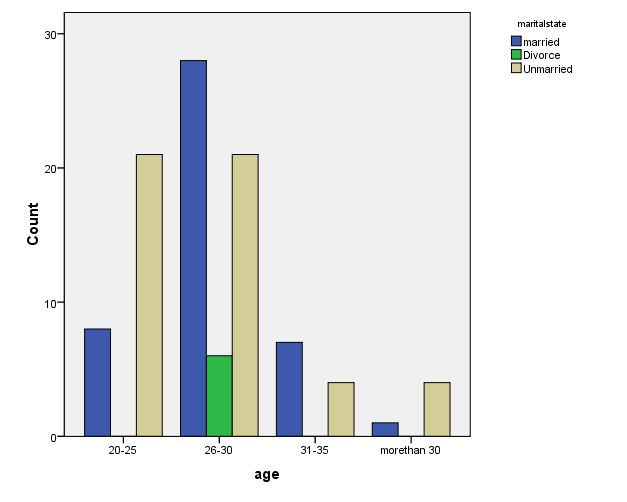 | Figure 1. Participants age and marital state distribution |
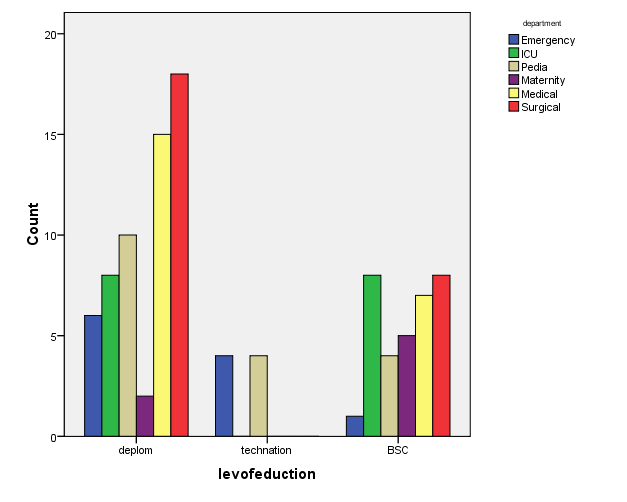 | Figure 2. Percentage distribution of participants level of education and departments |
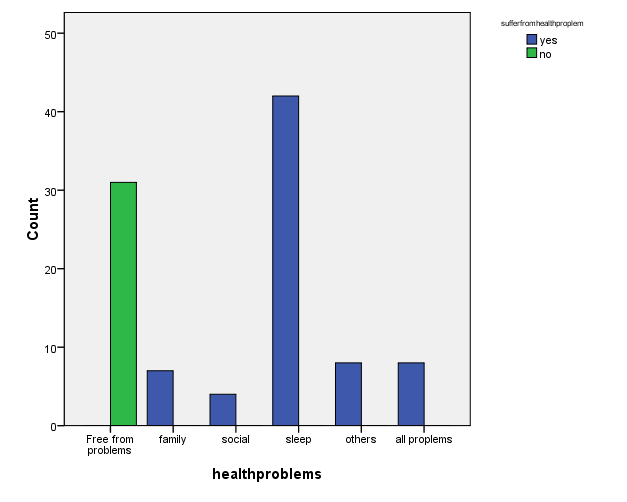 | Figure 3. Participants health problems distribution |
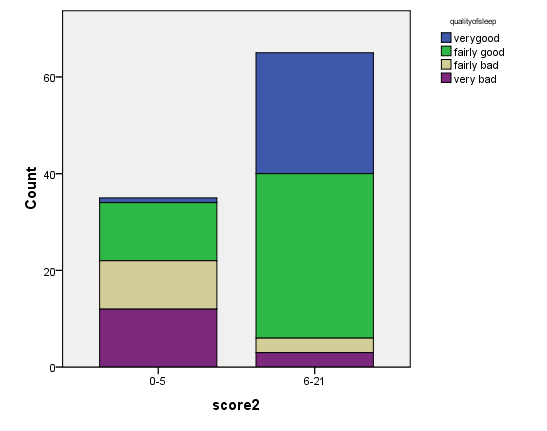 | Figure 4. Participants' quality of sleep and total sleep score distribution |
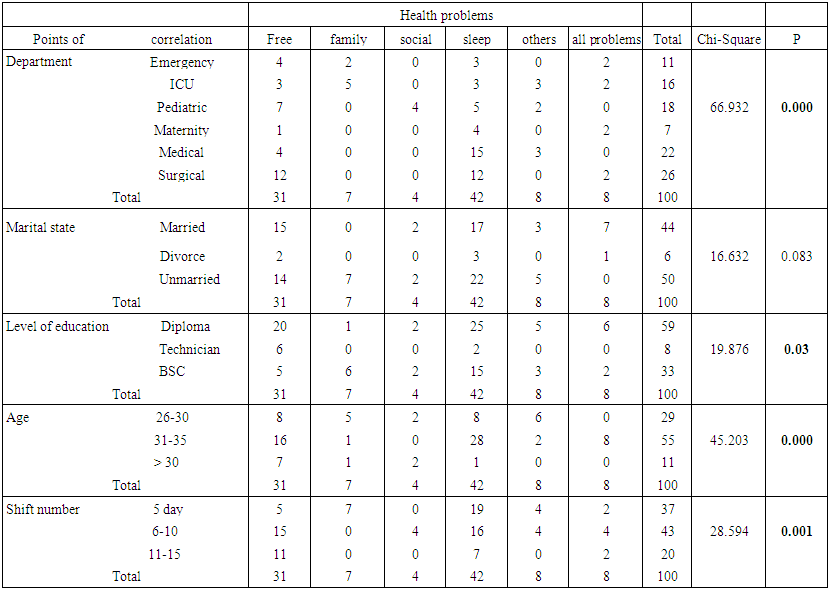 | Table (1). Relationship between Participants Reported Health Problems & Selected Factors (NO. 100) |
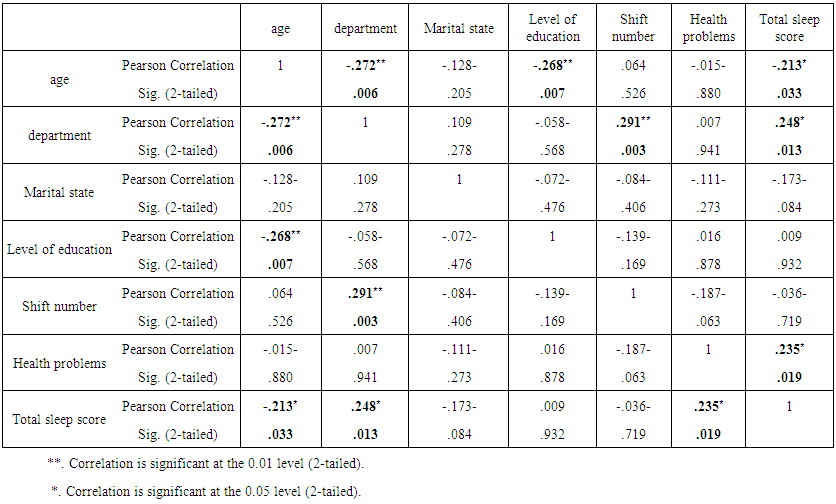 | Table (2). Correlation between Participants Demographic Characteristics', Health Problems & Total Sleep Score (NO. 100) |
4. Discussion
- This study was carried out to determine quality of sleep for nurses who were working in shift rotation and explore the relationship between sleep quality, demographic factors and health condition. Shift working is an unavoidable phenomenon in a health care system, harmful effects of shift working on physical, mental and social functions may happened. The results showed significant differences in prevalence of problems associated with shift work between case and control groups (75% in cases and 41% in controls). The highest incidence rate of problems was associated with impairment in social life with 86%. Incidence of such risks can be prevented through proper planning of the shift works, right section of the workers and providing favorable work conditions [25]. Medical surveillance of shift workers in the workplace can help detect early signs of severe sleep disturbances and, in turn, help diminish work accidents and absenteeism, which are both related to sleep disturbances in shift-working women [26].The result of current study revealed that more than half of participants aged between 26 to 30 year (55%), 29% aged between 20-25 year, only 11% have aged more than 30 year, nearly half of participants were married, half of participants not married and only 6% were divorced, 11% have baccalaureate degree in nursing, while more than half of participant were graduated from school of nursing (diploma degree) (fig.1 & 2). This results demonstrated that the baccalaureate degree in nursing may be newly introduced in south KSA Asser region, and they don’t accept to entering their girls in nursing education. More than 70% of the nurses reported having insufficient sleep, shift work schedules are important areas of future research; these should aim at finding the best compromise between productivity and employees’ sleep quality, health and performance. Several studies have reported that sleep problems are more common among nurses on rotating work shifts. Furthermore, nurses on rotating shifts were found to take more sick days and to give more serious reasons for these sick days relative to fixed shift workers [27]. The result of this study illustrated that 69% were suffering from health problems represented in family (7%), social (4%), sleep disturbance (42%), 8% complain from more than one from mentioned problems & 8% others problems that mentioned represent in travelling problems, low back pain and sometime their family refused to night shift. This may be due to the hospitals that working in it faraway the hose and some family refused driver for her daughter & must be travelling only with family person(father, husband or brother) (fig. 3 & 4). There were less impact on family and social problems, may be when the members of family are at home, can decrease the impact of shift rotation on sleep quality and health problems for who may be being away from the family at nights due to the work, this was the major kind of Saudian nationality that major family personnel in the same building, and beast family interaction that follow Islamic principles. This finding is inconsistent with Ghasem et.al. 2014, found that 98.3% of complaints were about personal, social and familial problems, and 84.9% were related to musculoskeletal disorders. Authors added that Satisfaction of rotating shift work and shift work voluntarily chosen variables, the rotation of the shift, shift work and adverse effects on personal life, adverse effects on family life revealed a significant relationship (P<0.05). Instead, insomnia common variables, adverse effects on social life and social problems showed no significant relationship [28]. A statistical significant was a found between department, level of education, age and shift days (table 1), also found between participant age and work department and level of education as well as between total sleep score age, department and health problems and between department & shift number (table 2). This finding is consistent with Choobineh and colleagues’ study [29], they found that there was a significant association between marital status and suffering from cardiovascular disorders caused by shift work, married employees had a greater risk than single ones. This indicates that married employees usually take more responsibilities in the family and society and experience more problems, also with Ramin et.al. 2015, founded that night shift work may contribute to an adverse chronic disease risk profile, and that risk factors may vary depending on the age at which night shift work was performed [30]. Participants suggestions to improve quality of sleep & health schedule must be flexible, planned rest periods in comfortable room, offering childcare services. In order to reduce problems and disorders that related to shift work in health institutions, authors offered the following suggestions: allowing voluntary shifts for the staff, shortening shift rotation, educating the shift workers in terms of their physical health and sleep hygiene, shortening the hours of night work, letting the night shift staff take a short nap, eating warm and suitable food during night shifts, limiting the employment of older employees in the shift work system, performing a physical exam for the new personnel, doing certain medical tests for the shift workers and the older personnel, and providing health and welfare facilities for the staff and their families [20]. In building a shift work schedule, securing enough period of night shift rotation interval has a benefit to maintain and improve the sleep quality of employees. Night shift rotation interval is correlated with numbers of rotation team, increasing numbers of team is accomplished to better quality of sleep. Future research should aim to find the most optimal model of shift work for minimizing human health effect [31].
5. Summary Conclusions & Recommendations
- Sleep is a basic human needs and fundamental for biological process need to be fulfilled. Shift rotations contribute to sleep quality and health problems, in turn accurate screening for sleep problems is essential. The result of study revealed to:- The prevalence of sleep quality disturbance as participants reported was 28%, while, 65% were suffering from impairment of sleep quality as measured by total sleep score - The associated health problems to shift rotation as reported were family problem 7%, social 4%, and 8% had more than one, and others problems includes back pain, travelling and family refusal to night shift. - There was a relationship between quality of sleep, health problems and shift rotation (P< 0.05).Based on the result of the study & participants suggestions, we recommended to:- Health institutions' must integrate shift work with resulting changes in staff personal lives.- Experienced nurses may transfer from day to night shifts for personal reasons.- Early detection for staff who suffer from impairment in sleep quality, related health problems and manages accordingly.- Continuously update & provide self-adaptive instructions & program.- Consider staff number in shift rotation to allow short nape in suitable room.
 Abstract
Abstract Reference
Reference Full-Text PDF
Full-Text PDF Full-text HTML
Full-text HTML